Security cameras aren’t one-size-fits-all, especially in the restaurant industry. Between the front counter, the dining area, the kitchen, and delivery zones, different environments call for different types of cameras.
Not all restaurant security cameras are built the same. Here’s how dome, turret, fisheye, pinhole, and bullet cameras compare, so you can find the best surveillance setup for your kitchen, dining area, and drive-thru.
Looking for a full restaurant camera buying guide? Click here.
1. Dome Security Cameras for Restaurants: A Solid All-Around Option
Best for: Entryways, dining areas, and cash registers
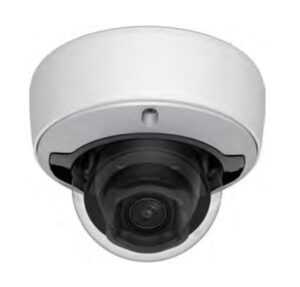
Dome cameras are enclosed in a clear, dome-shaped cover.
They’re discreet, difficult to tamper with, and offer wide-angle coverage. The design also hides the direction of the lens, which can help deter internal theft or suspicious activity.
Dome security cameras are popular with restaurant managers for their discreet design and reliable coverage of high-traffic areas like entrances and cash registers.
Pros:
- Vandal-resistant
- Discreet and blends into ceilings
- Good for front-of-house areas
- Wide-angle view for general surveillance
Considerations:
- May not perform as well in low-light without infrared support
- Harder to keep clean in kitchens or greasy areas due to enclosed body style
2. Fisheye Security Cameras for Restaurants: 360° Coverage from a Single Lens
Best for: Wide open areas like dining rooms or lobbies
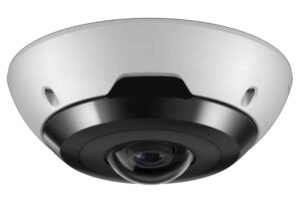
Fisheye cameras use a single ultra-wide lens to provide panoramic or 360-degree coverage.
One camera can cover a large area with minimal blind spots, ideal for restaurants looking to reduce hardware without sacrificing visibility.
Many restaurant owners use fisheye cameras to monitor large dining areas with just one device, making them a cost-effective solution for high-traffic spaces.
Pros:
- Covers a full area with one camera
- Fewer cameras = lower installation costs
- De-warping features allow flexible viewing angles
Considerations:
- Image distortion on the edges
- Less detail at a distance
3. Pinhole Cameras: When You Need to Stay Subtle
Best for: Point-of-sale (POS) stations, back offices, or above safes
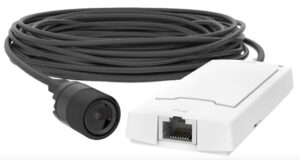
Pinhole cameras are small and discreet, often hidden inside objects or behind walls.
These are typically used for very targeted monitoring when you don’t want the camera to be obvious.
Pinhole cameras are often chosen by restaurants for discreet monitoring of sensitive spots like POS stations and back offices, helping reduce theft without alerting employees.
Pros:
- Highly discreet
- Can be integrated into existing fixtures
- Ideal for loss prevention
Considerations:
- Limited field of view
- Typically used alongside other cameras, not standalone
4. Turret Cameras: A Flexible and Popular Pick
Best for: Kitchens, drive-thrus, and outdoor areas with varied lighting
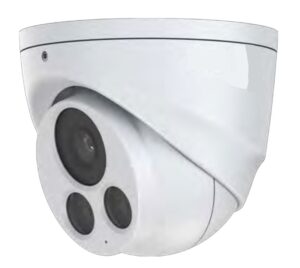
Turret cameras (also known as “eyeball” cameras) offer the same clarity as dome cameras without the plastic dome cover.
They’re easier to clean (no glare issues) and often include infrared night vision, great for greasy kitchen conditions or low-light back doors.
Turret cameras are favored in restaurant kitchens and outdoor drive-thru areas for their easy maintenance and ability to deliver clear video in varied lighting conditions.
Pros:
- Infrared night vision
- Flexible angle adjustment
- Easy to install and maintain
- Easier to keep clean thanks to the small, exposed lens area, ideal for messy environments like kitchens
Considerations:
- Slightly more visible than dome cameras
- Less vandal-resistant
5. Bullet Cameras: High Visibility, Long Range
Best for: Parking lots, delivery areas, and alleyways
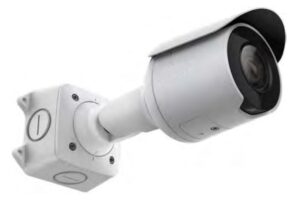
Bullet cameras are built to stand out. Literally.
Their long, cylindrical design is ideal for outdoor surveillance, particularly when capturing detailed footage over a distance.
Because they’re so visible, they can also act as a visual deterrent to theft or loitering.
Bullet cameras provide restaurants with long-range outdoor surveillance, making them ideal for parking lots and delivery zones where clear detail and visible deterrence matter most.
Pros:
- Excellent for long-range viewing
- Infrared capability for night vision
- Strong deterrent presence
Considerations:
- More prone to tampering or vandalism
- Not ideal for indoor use
Which Security Camera Is Best for Your Restaurant?
There’s no universal answer. It depends on your restaurant’s layout, lighting conditions, and unique security priorities. In many cases, using a combination of camera types offers the most comprehensive coverage.
To get the best results, it’s important to work with a security provider that conducts a thorough site survey. This ensures every critical area, from the kitchen to the drive-thru to POS stations, is properly covered on video.
Want more information on installing a restaurant security camera system? Here are the things to consider.
Choosing the Best Restaurant Security Camera for Your Layout
Whether you’re protecting your POS, overseeing your kitchen, or managing deliveries, the right camera makes all the difference.
At Envysion, we work with thousands of restaurant operators to build video solutions that drive real results, reducing losses, improving operations, and protecting your team.
Not sure where to start? Let’s talk about what kind of visibility your restaurant really needs.
